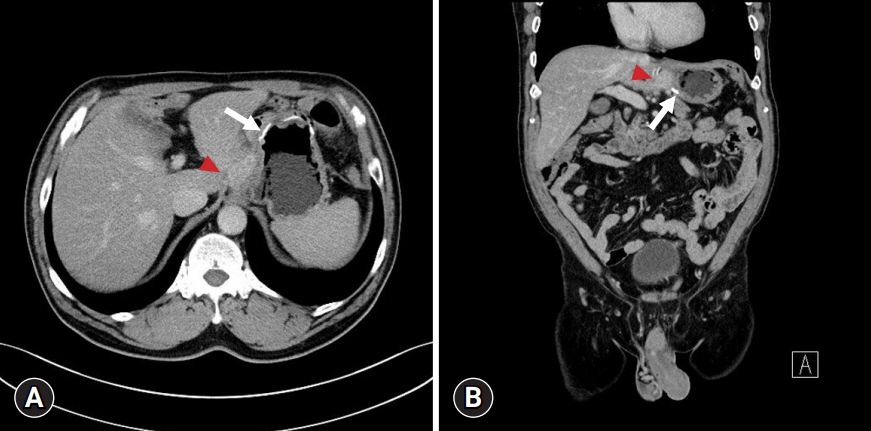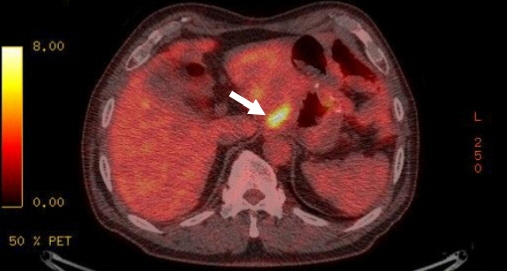J Yeungnam Med Sci.
2023 Oct;40(4):426-429. 10.12701/jyms.2022.00864.
Intraabdominal abscess mimicking gastric cancer recurrence: a case report
- Affiliations
-
- 1Department of Surgery, Yeungnam University College of Medicine, Daegu, Korea
- KMID: 2547368
- DOI: http://doi.org/10.12701/jyms.2022.00864
Abstract
- Surgical site infection is a common healthcare-associated infection that rarely occurs several months after surgery. Herein, a case is described in which an abdominal mass lesion was found at a 6-month follow-up visit after gastrectomy was performed for early gastric cancer. Positron emission tomography-computed tomography revealed a 2.5 cm-sized mass with a high maximal standard uptake value (8.32), located above a previous anastomosis site. Locoregional recurrence of gastric cancer was diagnosed by multidisciplinary team discussion, and explorative laparotomy was performed. However, surgical and pathologic findings revealed that the mass was an intraabdominal abscess. In conclusion, differential diagnosis of delayed abscess formation should be considered if the possibility of tumor recurrence is low, especially after early gastric cancer surgery.
Keyword
Figure
Reference
-
References
1. Kawai K, Sunami E, Nishikawa T, Tanaka J, Tanaka T, Kiyomatsu T, et al. Delayed abdominal wall abscess after abdomino-perineal resection simulating local recurrence of rectal cancer. Springerplus. 2014; 3:681.
Article2. Akinboboye O, Walls S. The Mass-Querade: lung abscess mimicking primary lung cancer. Cureus. 2022; 14:e27725.
Article3. Gundogdu N. A case of lung abscess mimicking lung cancer. J Coll Physicians Surg Pak. 2021; 31:1366–8.
Article4. Singh SM, Liu JL, Sedaghat F, Wethington SL, Atallah C, Kates M. Tubo-ovarian abscess: a potential mimicker of urachal malignancy. Urol Case Rep. 2022; 45:102191.
Article5. Jeong SJ, Ann HW, Kim JK, Choi H, Kim CO, Han SH, et al. Incidence and risk factors for surgical site infection after gastric surgery: a multicenter prospective cohort study. Infect Chemother. 2013; 45:422–30.
Article6. Korol E, Johnston K, Waser N, Sifakis F, Jafri HS, Lo M, et al. A systematic review of risk factors associated with surgical site infections among surgical patients. PLoS One. 2013; 8:e83743.
Article7. Kim JH, Heo SH, Kim JW, Shin SS, Min JJ, Kwon SY, et al. Evaluation of recurrence in gastric carcinoma: comparison of contrast-enhanced computed tomography and positron emission tomography/computed tomography. World J Gastroenterol. 2017; 23:6448–56.
Article8. Kim KA, Park CM, Park SW, Cha SH, Seol HY, Cha IH, et al. CT findings in the abdomen and pelvis after gastric carcinoma resection. AJR Am J Roentgenol. 2002; 179:1037–41.9. Lee HJ, Kim YH, Kim WH, Lee KU, Choe KJ, Kim JP, et al. Clinicopathological analysis for recurrence of early gastric cancer. Jpn J Clin Oncol. 2003; 33:209–14.
Article10. Yoo CH, Noh SH, Shin DW, Choi SH, Min JS. Recurrence following curative resection for gastric carcinoma. Br J Surg. 2000; 87:236–42.
Article11. Behera HS, Chayani N, Bal M, Khuntia HK, Pati S, Das S, et al. Identification of population of bacteria from culture negative surgical site infection patients using molecular tool. BMC Surg. 2021; 21:28.
Article12. Kozlov A, Bean L, Hill EV, Zhao L, Li E, Wang GP. Molecular identification of bacteria in intra-abdominal abscesses using deep sequencing. Open Forum Infect Dis. 2018; 5:ofy025.
Article
- Full Text Links
- Actions
-
Cited
- CITED
-
- Close
- Share
- Similar articles
-
- Nomogram Estimating the Probability of Intraabdominal Abscesses after Gastrectomy in Patients with Gastric Cancer
- Crohn's Disease with Intraabdominal Abscess as the Initial Diagnosis
- Percutaneous catheter drainage of intraabdominal abscess
- Sonographic diagnosis of intraabdominal abscess
- A Case of Gastrocolic Fistula Secondary to Colon Cancer




